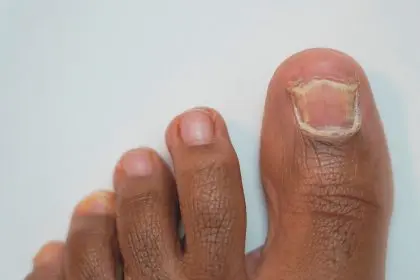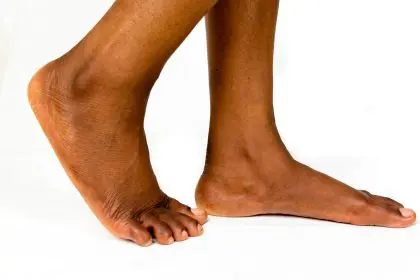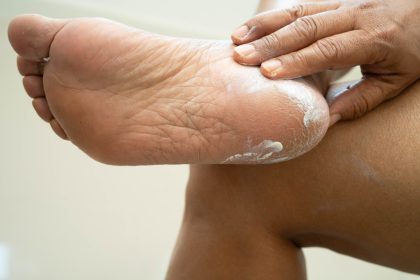Toenail discoloration can be more than just a cosmetic issue; it can be an indicator of underlying foot health problems. Changes in the color, texture, and thickness of your toenails can reveal a lot about your overall health and hygiene. In this article, we will explore the common causes of toenail discoloration and what they might signify about your foot health.
Common causes of toenail discoloration
Fungal infections
Signs and symptoms
Fungal infections are a common cause of toenail discoloration, often leading to yellow, brown, or white nails. These infections can cause the nail to become thick, brittle, and crumbly. Common fungal infections include athlete’s foot and onychomycosis.
Prevention and treatment
- Keep your feet dry and clean: Fungus thrives in warm, moist environments. Dry your feet thoroughly after bathing and wear breathable shoes and socks.
- Use antifungal treatments: Over-the-counter antifungal creams and powders can help treat mild infections. For severe cases, consult a healthcare professional for prescription medication.
- Avoid walking barefoot in public areas: Wear flip-flops or shower shoes in communal showers, locker rooms, and around pools to prevent infection.
Trauma
Signs and symptoms
Trauma to the toenail, such as stubbing your toe or dropping something heavy on it, can cause discoloration. This may result in black, blue, or purple nails due to blood pooling under the nail, known as a subungual hematoma.
Prevention and treatment
- Protect your feet: Wear appropriate footwear to prevent injuries, especially when engaging in activities that pose a risk to your toes.
- Seek medical attention for severe injuries: If you experience severe pain or if the nail becomes detached, consult a healthcare professional for proper care and treatment.
Psoriasis
Signs and symptoms
Psoriasis is a chronic skin condition that can also affect the nails, leading to discoloration, pitting, and thickening. Toenails may turn yellow-brown and develop ridges or become separated from the nail bed.
Prevention and treatment
- Manage psoriasis: Work with a dermatologist to develop a treatment plan that may include topical treatments, light therapy, and systemic medications.
- Keep nails trimmed and clean: Regular nail care can help prevent complications and improve the appearance of affected nails.
Bacterial infections
Signs and symptoms
Bacterial infections can cause toenails to turn green or black. This is often due to bacteria such as Pseudomonas, which can thrive in moist environments and under loose or damaged nails.
Prevention and treatment
- Keep feet dry and clean: Similar to fungal infections, keeping your feet dry and clean can help prevent bacterial infections.
- Use antibiotic treatments: Over-the-counter antibiotic ointments may help with minor infections. For more severe cases, consult a healthcare professional for prescription antibiotics.
Nutritional deficiencies
Signs and symptoms
Nutritional deficiencies, particularly in vitamins and minerals like zinc and iron, can lead to toenail discoloration. Nails may appear pale, white, or yellowish if the body lacks essential nutrients.
Prevention and treatment
- Eat a balanced diet: Ensure your diet includes a variety of fruits, vegetables, lean proteins, and whole grains to provide essential nutrients.
- Consider supplements: If you suspect a deficiency, consult a healthcare professional who may recommend dietary supplements.
Melanoma
Signs and symptoms
Melanoma, a type of skin cancer, can occasionally manifest as dark streaks or spots under the toenail. This discoloration is usually brown or black and may change in appearance over time.
Prevention and treatment
- Monitor changes: Keep an eye on any new or changing discoloration under the nail. If you notice any unusual changes, consult a healthcare professional immediately.
- Early detection is key: Early diagnosis and treatment of melanoma are crucial for a positive outcome.
Conclusion: Taking care of your toenails
Toenail discoloration can be a sign of various underlying health issues, ranging from minor infections to serious conditions like melanoma. Maintaining good foot hygiene is essential in preventing many of these issues. Regular washing and thorough drying of your feet can keep fungal and bacterial infections at bay. Wearing appropriate footwear that provides protection and allows your feet to breathe can also prevent trauma and reduce the risk of infections.
Seeking medical advice when you notice changes in your toenails is crucial. Early intervention can prevent minor issues from becoming serious problems. Regularly inspecting your toenails for changes in color, texture, or thickness can provide early warning signs of potential health problems. Understanding these signs allows for timely intervention and treatment, ensuring that your feet remain healthy and strong.
Incorporating these practices into your routine can significantly contribute to your overall well-being. Healthy toenails are not just about aesthetics; they are indicative of good foot health and, by extension, good overall health. Taking proactive steps in foot care can lead to better health outcomes and a higher quality of life.
This story was created using AI technology.












